Developing a Strategic Sustainability Assessment Methodology for Free Zones Using the Analytical Hierarchy Process Approach
Abstract
1. Introduction
2. Literature Review
2.1. Free Zones Overview
2.2. Free Zones Sustainability
2.3. Free Zone Sustainability Assessment Indicators
2.3.1. Economic Sustainability Assessment Indicators
2.3.2. Environmental Sustainability Assessment Indicators
2.3.3. Social Sustainability Assessment Indicators
2.3.4. Organizational Sustainability Assessment Indicators
2.4. Free Zone Sustainability Assessment Tools
3. Materials and Methods
3.1. Model Development
3.2. Solution Methodology
4. Results
4.1. AHP Application and Results
4.2. Sensitivity Analysis
5. Discussion
6. Conclusions
Author Contributions
Funding
Institutional Review Board Statement
Informed Consent Statement
Data Availability Statement
Conflicts of Interest
References
- UNCTAD. World Investment Report 2019: Special Economic Zones, Key Messages and Overview. United Nations Conference on Trade and Development. 2019. Available online: https://unctad.org/en/PublicationsLibrary/wir2019_en.Pdf (accessed on 1 July 2022).
- IEA (International Energy Agency). Global CO2 Emissions in 2019. International Energy Agency 2019. Available online: https://www.iea.org/articles/global-co2-emissions-in-2019 (accessed on 10 August 2022).
- European Commission. Reducing Emissions from the Shipping Sector. 2021. Available online: https://ec.europa.eu/clima/policies/transport/shipping_en (accessed on 15 October 2022).
- Muangpan, T.; Suthiwartnarueput, K. Key Performance Indicators of Sustainable Port: Case Study of the Eastern Economic Corridor in Thailand. Cogent Bus. Manag. 2019, 6, 1603275. [Google Scholar] [CrossRef]
- Oh, H.; Lee, S.W.; Seo, Y.J. The Evaluation of Seaport Sustainability: The Case of South Korea. Ocean Coast. Manag. 2018, 161, 50–56. [Google Scholar] [CrossRef]
- Park, K.; De, P. An Alternative Approach to Efficiency Measurement of Seaports. In Port Management; Palgrave Macmillan: London, UK, 2015; pp. 273–292. [Google Scholar] [CrossRef]
- Parola, F.; Risitano, M.; Ferretti, M.; Panetti, E. The Drivers of Port Competitiveness: A Critical Review. Transp. Rev. 2017, 37, 116–138. [Google Scholar] [CrossRef]
- UNCTAD. World Investement Report 2015: Reforming International Investment Governance. United Conference on Trade and Development. 2015. Available online: https://unctad.org/en/PublicationsLibrary/wir2015_en.pdf (accessed on 25 June 2022).
- Saaty, R.W. The Analytic Hierarchy Process—What It Is and How It Is Used. Math. Model. 1987, 9, 161–176. [Google Scholar] [CrossRef]
- Lirn, T.C.; Jim Wu, Y.C.; Chen, Y.J. Green Performance Criteria for Sustainable Ports in Asia. Int. J. Phys. Distrib. Logist. Manag. 2013, 43, 427–451. [Google Scholar] [CrossRef]
- Chiu, R.H.; Lin, L.H.; Ting, S.C. Evaluation of Green Port Factors and Performance: A Fuzzy AHP Analysis. Math. Probl. Eng. 2014, 2014, 802976. [Google Scholar] [CrossRef]
- Wan, C.; Zhang, D.; Yan, X.; Yang, Z. A Novel Model for the Quantitative Evaluation of Green Port Development—A Case Study of Major Ports in China. Transp. Res. Part D Transp. Environ. 2017, 61, 431–443. [Google Scholar] [CrossRef]
- Sengar, V.S.; Garg, C.P.; Raju, T.B. Assessment of Sustainable Initiatives in Indian Ports Using AHP Framework. Int. J. Bus. Excell. 2018, 16, 110–126. [Google Scholar] [CrossRef]
- Trampus, F. Challenges, Threats and New Opportunities for the World’s Free Zone. Trasp. Dirit. Econ. Politica 2003, 89, 59–76. Available online: https://hdl.handle.net/10077/5595 (accessed on 4 April 2022).
- Grubel, H.G. Free Economic Zones: Good or Bad? Aussenwirtschaft 1984, 39, 43–56. [Google Scholar]
- Guangwen, M. The Theory and Practice of Free Economic Zones: A Case Study of Tianjin, People’s Republic of China. Ph.D. Thesis, Universität Heidelberg, Heidelberg, Germany, 2003. [Google Scholar] [CrossRef]
- Bost, F. The World of Free Zones; World Free Zone Organization: Dubai, United Arab Emirates, 2015. [Google Scholar]
- Akinci, G.; Crittle, J. Special Economic Zones: Performance, Lessons Learned, and Implications for Zone Development; The World Bank: Washington, DC, USA, 2008; pp. 1–83. [Google Scholar]
- Chiu, R.H.; Lirn, T.C.; Li, C.Y.; Lu, B.Y.; Shang, K.C. An Evaluation of Free Trade Port Zone in Taiwan. Asian J. Shipp. Logist. 2011, 27, 423–445. [Google Scholar] [CrossRef]
- Chen, J.; Wan, Z.; Zhang, F.; Park, N.K.; Zheng, A.; Zhao, J. Evaluation and Comparison of the Development Performances of Typical Free Trade Port Zones in China. Transp. Res. Part A Policy Pract. 2018, 118, 506–526. [Google Scholar] [CrossRef]
- Hsu, W.K.K.; Huang, S.H.S.; Huynh, N.T. An Evaluation Model for Foreign Direct Investment Performance of Free Trade Port Zones. Promet-Traffic Transp.-Traffic-Traffico 2021, 33, 859–870. [Google Scholar] [CrossRef]
- Bost, F. Special Economic Zones: Methodological Issues and Definition. Transnatl. Corp. 2019, 26, 141–153. [Google Scholar] [CrossRef]
- World Bank. Export Processing Zones; Industry and Development Division; Policy and Research Series Paper No. 20; World Bank: Washington, DC, USA, 1992. [Google Scholar]
- DAPhNE. Guidelines for Industrial Development Initiatives in Ports. Interreg Danube Transnational Programme. 2018. Available online: https://www.interregdanube.eu/uploads/media/approved_project_public/0001/27/b18d6ffc220bb6b66426ecb4e5b0d9e04eb4e9b7.pdf (accessed on 1 May 2022).
- IISD. Sustainable Development. International Institute for Sustainable Development. 2020. Available online: https://www.iisd.org/about-iisd/sustainable-development#:~:text=%22 (accessed on 1 June 2021).
- Anon. Embracing the Concept of Sustainability as a Standard Practice for Ports and the Association; Authorities, American Association of Port: Washington, DC, USA, 2007. [Google Scholar]
- WCED. Imperatives Strategic, Report of Our Common Future. World Commission on Environment and Development, 1987. Available online: https://sustainabledevelopment.un.org/content/documents/5987our-common-future.pdf (accessed on 4 October 2022).
- Dekker, S.; Hartman, J.; Postma, H. Sustainable Port Development in the Netherlands–Framework for a Comprehensive Approach Applied to Amsterdam Port. In Proceedings of the 12th WCTR Strategic Consultant Transport & Economics, Grontmij Nederland Bv, Lisbon, Portugal, 11–15 July 2010. [Google Scholar]
- Laxe, F.G.; Bermúdez, F.M.; Palmero, F.M.; Novo-Corti, I. Assessment of Port Sustainaility Through Synthetic Indexes: Application to the Spanish case. Mar. Pollut. Bull. 2017, 119, 220–225. [Google Scholar] [CrossRef]
- WFZO. Free Zone of the Future, Path to Prosperity, Izdihar Index. World Free Zone Organization, 2018. Available online: https://www.worldfzo.org/Portals/0/OpenContent/Files/614/Izdihar_Index_Free_zone_of_the_Future.pdf (accessed on 18 September 2022).
- Buaban, S.; Nitivattananon, V.; Shrestha, S. Sustainability Indicators as a Key for Sustainable Development of Special Border Economic Zones. GMSARN Int. J. 2020, 14, 169–177. Available online: http://gmsarnjournal.com/home/wp-content/uploads/2020/02/vol14no3-8.pdf (accessed on 1 October 2022).
- Lam, J.S.L.; Li, K.X. Green Port Marketing for Sustainable Growth and Development. Transp. Policy 2019, 84, 73–81. [Google Scholar] [CrossRef]
- Roh, S.; Thai, V.V.; Wong, Y.D. Towards Sustainable Asean Port Development: Challenges and Opportunities for Vietnamese Ports. Asian J. Shipp. Logist. 2016, 32, 107–118. [Google Scholar] [CrossRef]
- Ashby, A.; Leat, M.; Hudson-Smith, M. Making Connections: A Review of Supply Chain Management and Sustainability Literature. Supply Chain. Manag. Int. J. 2012, 17, 497–516. [Google Scholar] [CrossRef]
- Dinwoodie, J. Sustainability Management in Smaller UK Ports to Promote More Sustainable Freight Transport. Sustain. Freight Transp. 2018, 63, 31–46. [Google Scholar] [CrossRef]
- Ahmadi, H.B.; Kusi-Sarpong, S.; Rezaei, J. Assessing the Social Sustainability of Supply Chains Using Best Worst Method. Resour. Conserv. Recycl. 2017, 126, 99–106. [Google Scholar] [CrossRef]
- Schaltegger, S.; Wagner, M. Sustainable Entrepreneurship and Sustainability Innovation: Categories and Interactions. Bus. Strategy Environ. 2011, 20, 222–237. [Google Scholar] [CrossRef]
- Tan, Y.; Shen, L.; Yao, H. Sustainable Construction Practice and Contractors’ Competitiveness: A Preliminary Study. Habitat Int. 2011, 35, 225–230. [Google Scholar] [CrossRef]
- Kannika, N.; Tan, K.H.; Pawar, K. Enhancing the Competitiveness of Container Seaports Through Sustainability: A Case Study of Thailand. Procedia Manuf. 2019, 39, 1587–1596. [Google Scholar] [CrossRef]
- Lu, C.S.; Shang, K.C.; Lin, C.C. Identifying Crucial Sustainability Assessment Criteria for International Ports. In Proceedings of the International Forum on Shipping: Ports Airports, Hong Kong, China, 27–30 May 2012. [Google Scholar]
- Schipper, C.A.; Vreugdenhil, H.; De Jong, M.P.C. A Sustainability Assessment of Ports and Port-City Plans: Comparing Ambitions with Achievements. Transp. Res. Part D Transp. Environ. 2017, 57, 84–111. [Google Scholar] [CrossRef]
- Moldavska, A.; Welo, T. A Holistic Approach to Corporate Sustainability Assessment: Incorporating Sustainable Development Goals into Sustainable Manufacturing Performance Evaluation. J. Manuf. Syst. 2019, 50, 53–68. [Google Scholar] [CrossRef]
- Shiau, T.A.; Chuang, C. Social Construction of Port Sustainability Indicators: A Case Study of Keelung Port. Marit. Policy Manag. 2015, 42, 26–42. [Google Scholar] [CrossRef]
- Olfat, L.; Amiri, M.; Soufi, J.B.; Pishdar, M. A Dynamic Network Efficiency Measurement of Airports Performance Considering Sustainable Development Concept: A Fuzzy Dynamic Network-DEA Approach. J. Air Transp. Manag. 2016, 57, 272–290. [Google Scholar] [CrossRef]
- Asgari, N.; Hassani, A.; Jones, D.; Nguye, H.H. Sustainability Ranking of the UK Major Ports: Methodology and Case Study. Transp. Res. Part E Logist. Transp. Rev. 2015, 78, 19–39. [Google Scholar] [CrossRef]
- Greer, F.; Rakas, J.; Horvath, A. Airports and Environmental Sustainability: A Comprehensive Review. Environ. Res. Lett. 2020, 15, 103007. [Google Scholar] [CrossRef]
- Lim, S.; Pettit, S.; Abouarghoub, W.; Beresford, A. Port Sustainability and Performance: A Systematic Literature Review. Transp. Res. Part D Transp. Environ. 2019, 72, 47–64. [Google Scholar] [CrossRef]
- Lam, J.S.L.; Notteboom, T. The Greening of Ports: A Comparison of Port Management Tools Used by Leading Ports in Asia and Europe. Transp. Rev. 2014, 34, 169–189. [Google Scholar] [CrossRef]
- Guo, F.; Diao, J.; Zhao, Q.; Wang, D.; Sun, Q. A Double-Level Combination Approach for Demand Forecasting of Repairable Airplane Spare Parts Based on Turnover Data. Comput. Ind. Eng. 2017, 110, 92–108. [Google Scholar] [CrossRef]
- Wicher, P.; Zapletal, F.; Lenort, R. Sustainability Performance Assessment of Industrial Corporation Using Fuzzy Analytic Network Process. J. Clean. Prod. 2019, 241, 118132. [Google Scholar] [CrossRef]
- Taddese, G.; Durieux, S.; Duc, E. Sustainability Performance Evaluation of Faceshield Bracket Manufacturing by Using the Analytic Hierarchy Process. Sustainability 2021, 13, 13883. [Google Scholar] [CrossRef]
- Kaymaz, Ç.K.; Birinci, S.; Kızılkan, Y. Sustainable Development Goals Assessment of Erzurum Province with SWOT-AHP Analysis. Environ. Dev. Sustain. 2022, 24, 2986–3012. [Google Scholar] [CrossRef]
- Gompf, K.; Traverso, M.; Hetterich, J. Using Analytical Hierarchy Process (AHP) to Introduce Weights to Social Life Cycle Assessment of Mobility Services. Sustainability 2021, 13, 1258. [Google Scholar] [CrossRef]
- Wu, X.; Yang, H.-C. An Ecological Sustainability Assessment Approach for Strategic Decision Making in International Shipping. Sustainability 2021, 13, 11471. [Google Scholar] [CrossRef]
- Mastos, T.; Gkotzamani, K.; Kafetzopoulos, D. Development and Validation of a Measurement Instrument for Sustainability in Food Supply Chains. Sustainability 2022, 14, 5203. [Google Scholar] [CrossRef]
- Gibbs, D.; Rigot-Muller, P.; Mangan, J.; Lalwani, C. The Role of Sea Ports in End-to-End Maritime Transport Chain Emissions. Energy Policy 2014, 64, 337–348. [Google Scholar] [CrossRef]
- Rostamnezhad, M.; Thaheem, M.J. Social Sustainability in Construction Projects—A Systematic Review of Assessment Indicators and Taxonomy. Sustainability 2022, 14, 5279. [Google Scholar] [CrossRef]
- Labuschagne, C.; Brent, A.C.; Van Erck, R.P. Assessing the Sustainability Performances of Industries. J. Clean. Prod. 2005, 13, 373–385. [Google Scholar] [CrossRef]
- Ng, A.W.; Tavitiyaman, P. Corporate Social Responsibility and Sustainability Initiatives of Multinational Hotel Corporations. In International Business, Trade and Institutional Sustainability; Springer: Cham, Switzerland, 2020; pp. 3–15. [Google Scholar]
- Roy, B. Multicriteria Methodology for Decision Aiding; Springer: Boston, MA, USA, 1996; Volume 12, ISBN 978-1-4757-2500-1. [Google Scholar]
- Costa, A.S.; Lami, I.M.; Greco, S.; Figueira, J.R.; Borbinha, J. A Multiple Criteria Approach Defining Cultural Adaptive Reuse of Abandoned Buildings. Int. Ser. Oper. Res. Manag. Sci. 2019, 274, 193–220. [Google Scholar] [CrossRef]
- Munier, N.; Hontoria, E. Uses and Limitations of the AHP Method: A Non-Mathematical and Rational Analysis; Springer International Publishing: Berlin/Heidelberg, Germany, 2021. [Google Scholar] [CrossRef]
- Kaya, T.; Kahraman, C. Multicriteria Decision Making in Energy Planning Using a Modified Fuzzy TOPSIS Methodology. Expert Syst. Appl. 2011, 38, 6577–6585. [Google Scholar] [CrossRef]
- Reed, M.S. Stakeholder Participation for Environmental Management: A Literature Review. Biol. Conserv. 2008, 141, 2417–2431. [Google Scholar] [CrossRef]
- Ojokoh, B.A.; Samuel, O.W.; Omisore, O.M.; Sarumi, O.A.; Idowu, P.A.; Chimusa, E.R.; Darwish, A.; Adekoya, O.A.; Katsriku, F.A. Big Data, Analytics and Artificial Intelligence for Sustainability. Sci. Afr. 2020, 9, e00551. [Google Scholar] [CrossRef]
- Abdel-Basset, M.; Gamal, A.; Chakrabortty, R.K.; Ryan, M.J. Evaluation Approach for Sustainable Renewable Energy Systems Under Uncertain Environment: A Case Study. Renew. Energy 2021, 168, 1073–1095. [Google Scholar] [CrossRef]
- Joint Research Centre-European Commission. Handbook on Constructing Composite Indicators: Methodology and User Guide; OECD Publishing: Paris, France, 2008. [Google Scholar] [CrossRef]
- Forman, E.H. The Analytic Hierarchy Process as a Decision Support System. In Proceedings of the IEEE Computer Society, Pasadena, CA, USA, 12–14 October 1983. [Google Scholar]
- Saaty, T.L.; Vargas, L.G. The Seven Pillars of the Analytic Hierarchy Process. Int. Ser. Oper. Res. Manag. Sci. 2012, 175, 23–40. [Google Scholar] [CrossRef]
- Lee, G.K.; Chan, E.H. The Analytic Hierarchy Process (AHP) Approach for Assessment of Urban Renewal Proposals. Soc. Indic. Res. 2008, 89, 155–168. [Google Scholar] [CrossRef]
- Saaty, T.L. Decision Making with the Analytic Hierarchy Process. Int. J. Serv. Sci. 2008, 1, 83–98. [Google Scholar] [CrossRef]
- Jalaliyoon, N.; Bakar, N.A.; Lumpur, K.; Taherdoost, M.H. Accomplishment of Critical Success Factor in Organization; Using Analytic Hierarchy Process. Int. J. Acad. Res. Manag. 2012, 1, 1–9. [Google Scholar]
- Golden, B.L.; Wang, Q. An Alternate Measure of Consistency Analitical Hierarchy Process: Applications and Studies; Springer: Berlin/Heidelberg, Germany, 1989; pp. 68–81. [Google Scholar]
- Dyson, R. Performance Measurement and Data Envelopment Analysis: Rankings are rank! OR Insight 2000, 13, 3–8. [Google Scholar] [CrossRef]
- KaurSehra, S.; Singh Brar, Y.; Kaur, N. Multi Criteria Decision Making Approach for Selecting Effort Estimation Model. Int. J. Comput. Appl. 2012, 39, 10–17. [Google Scholar] [CrossRef]
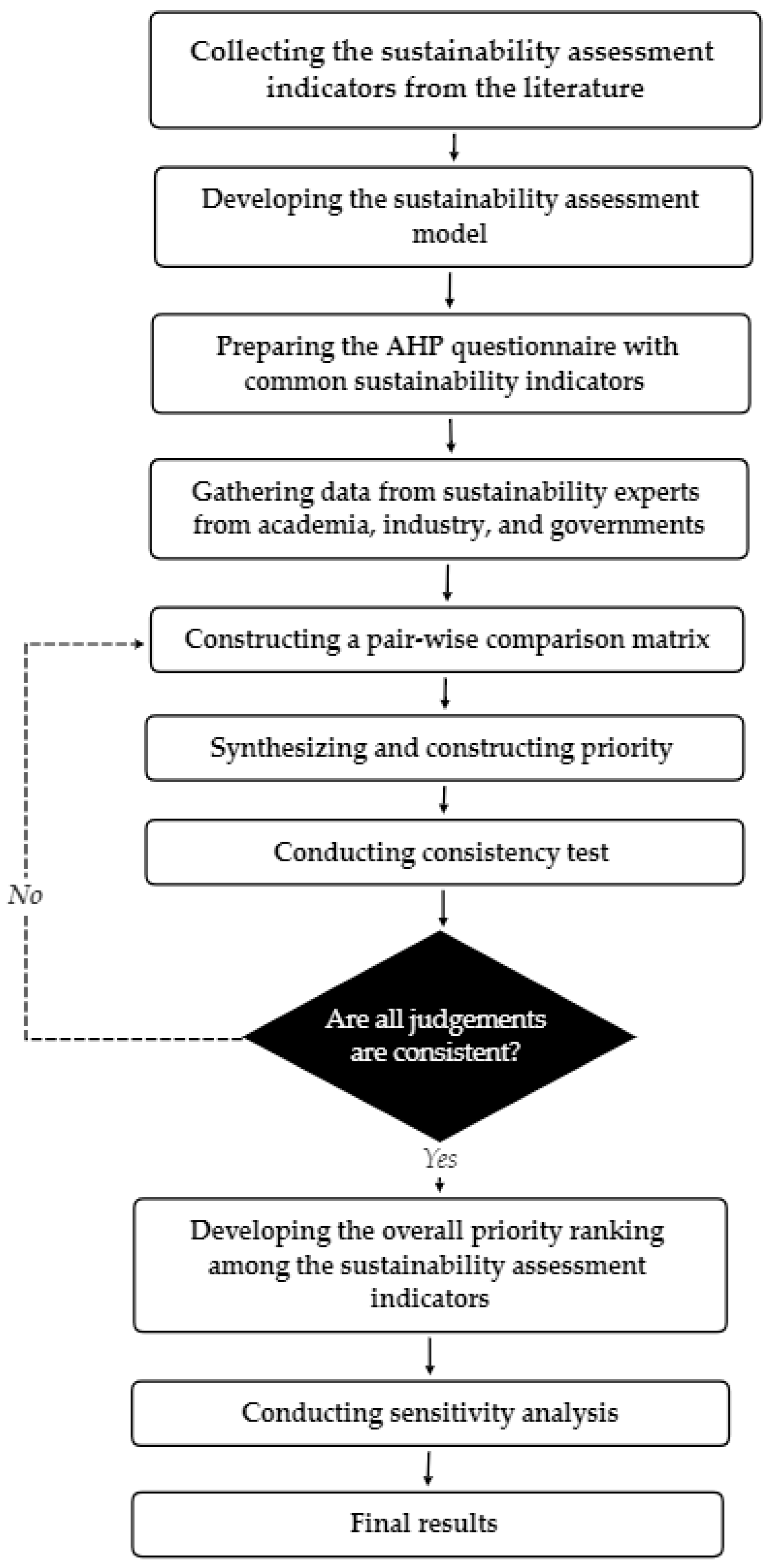

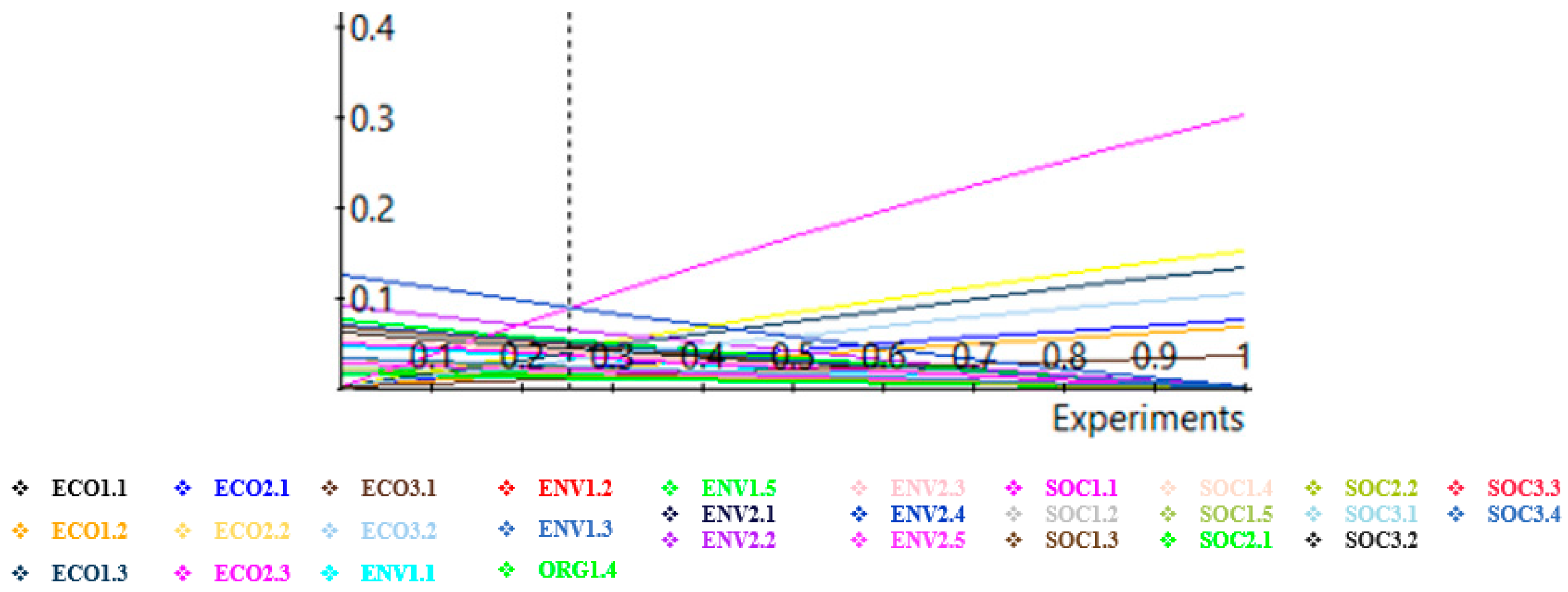
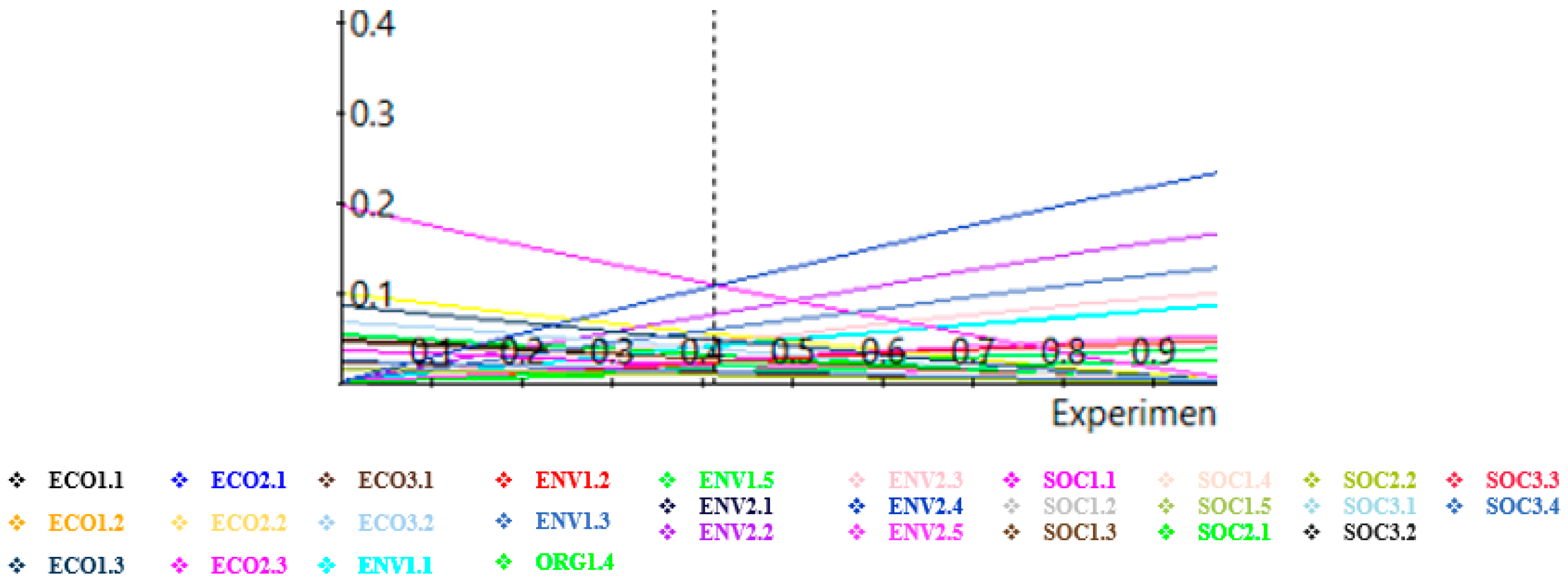
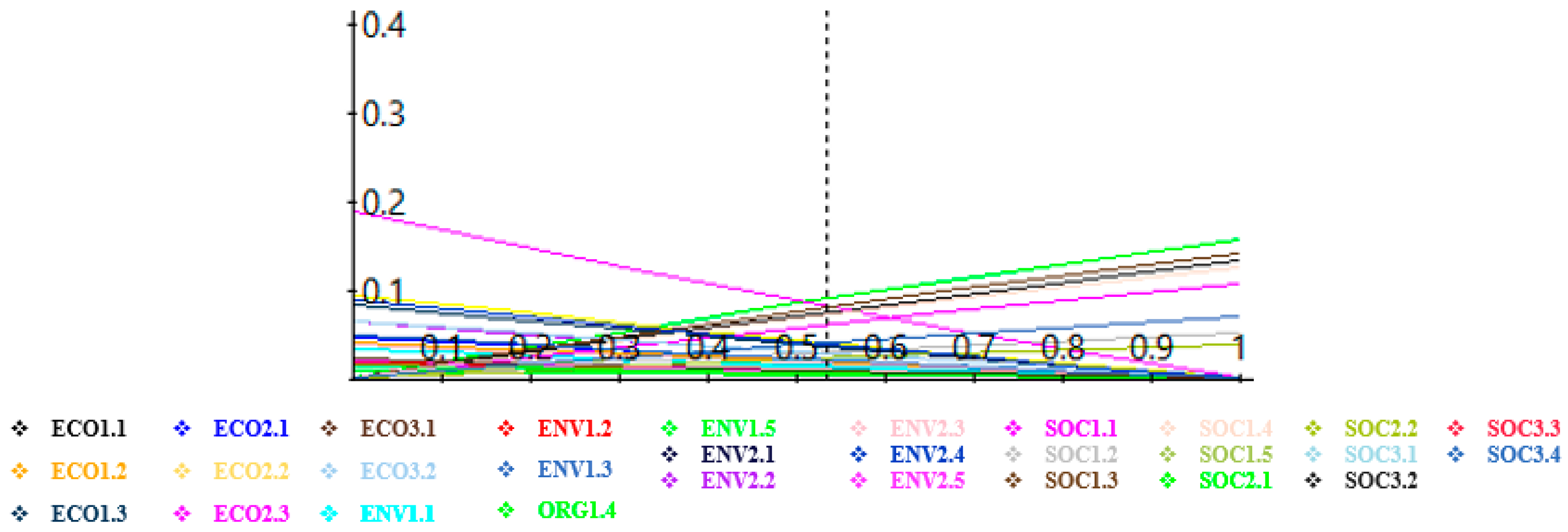

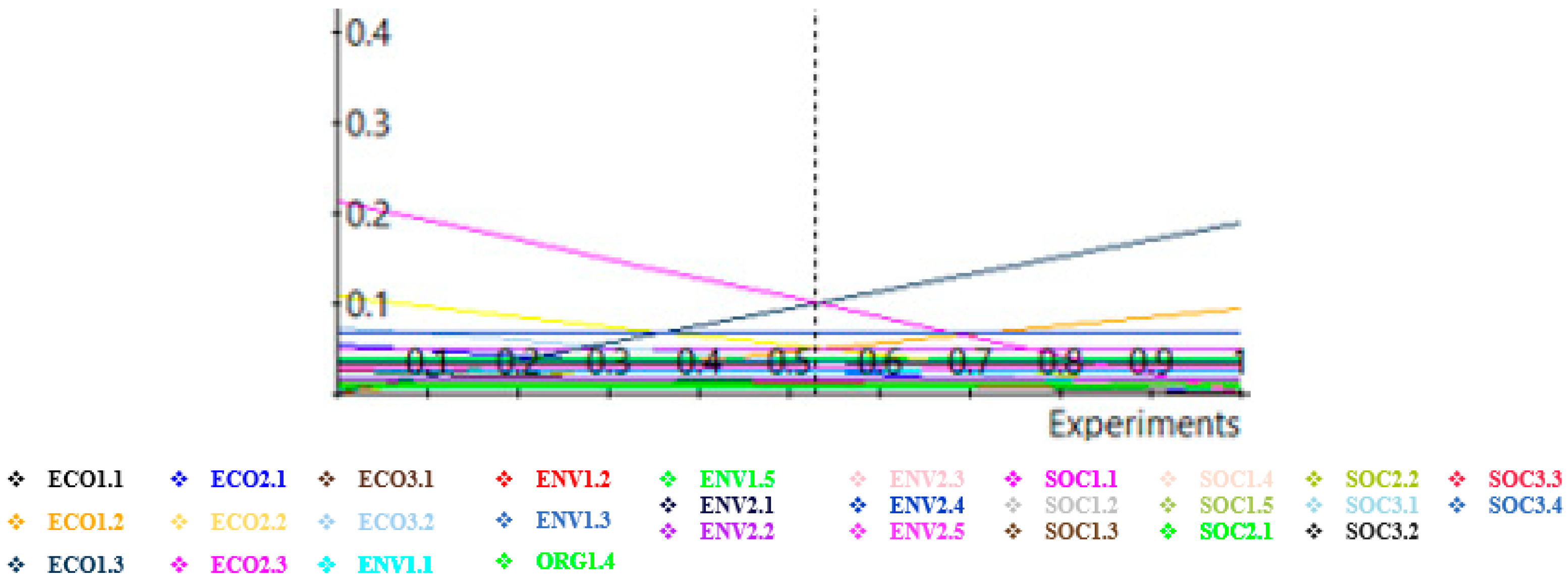
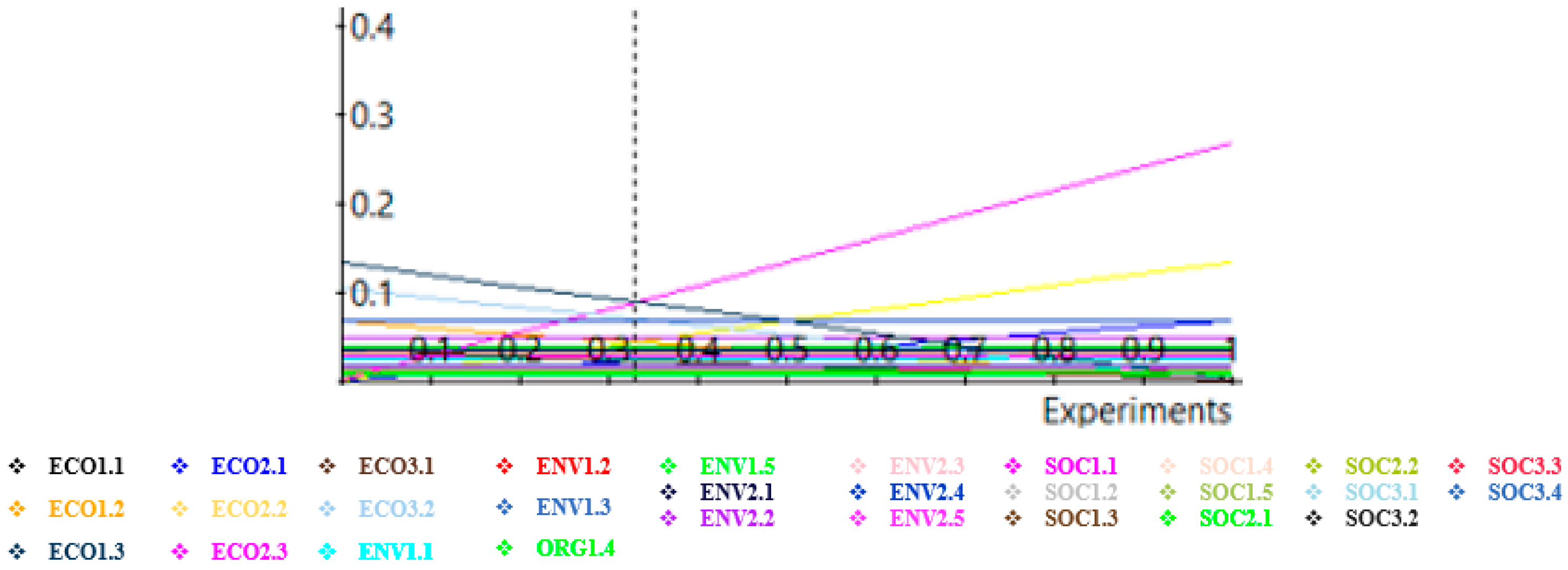
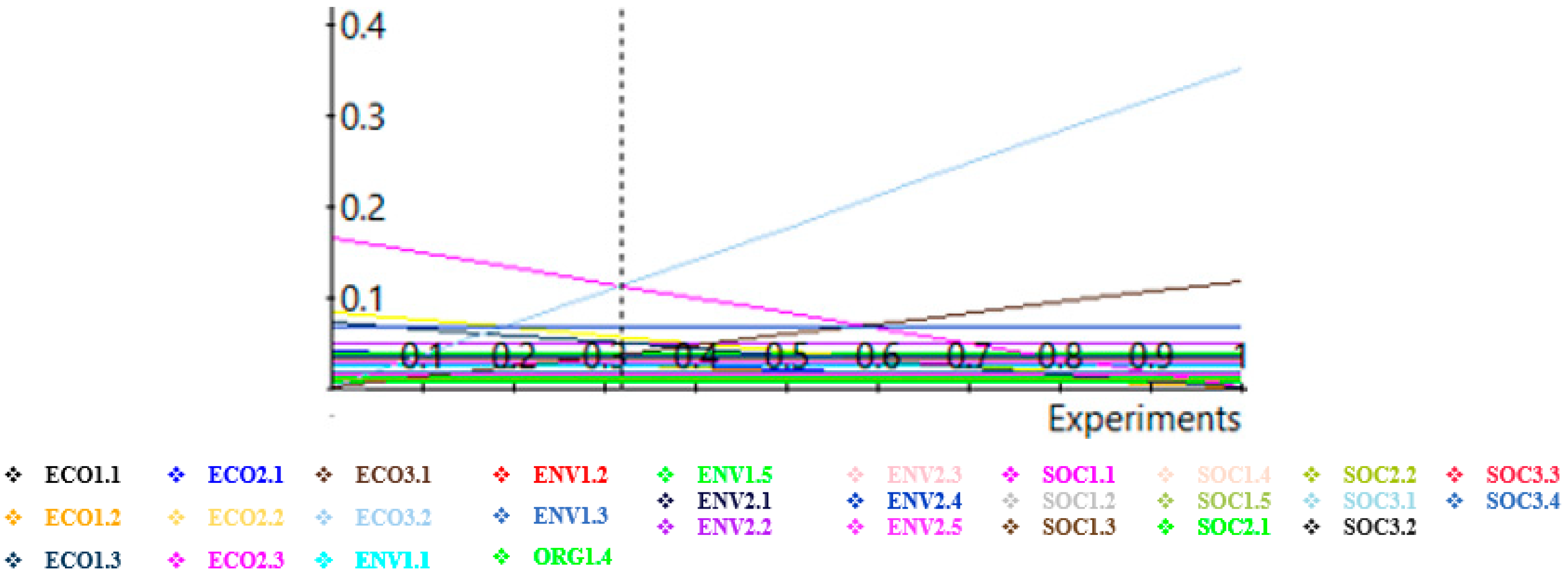
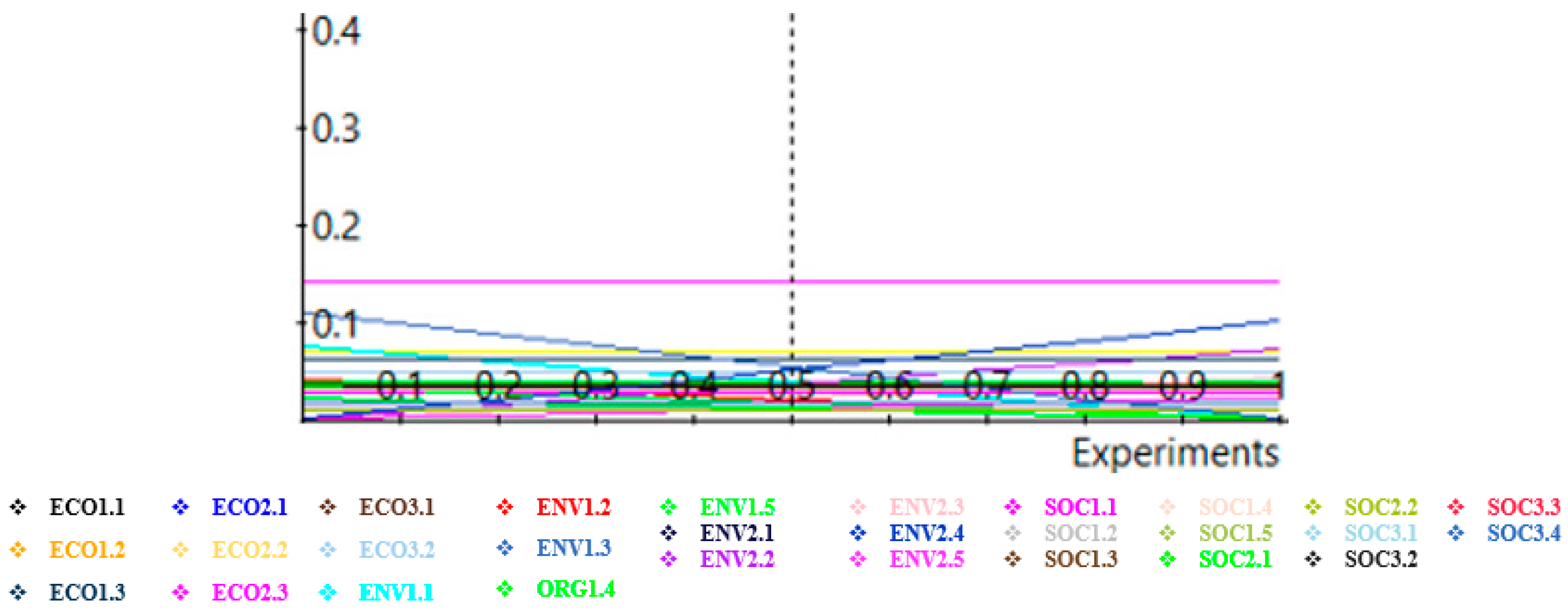
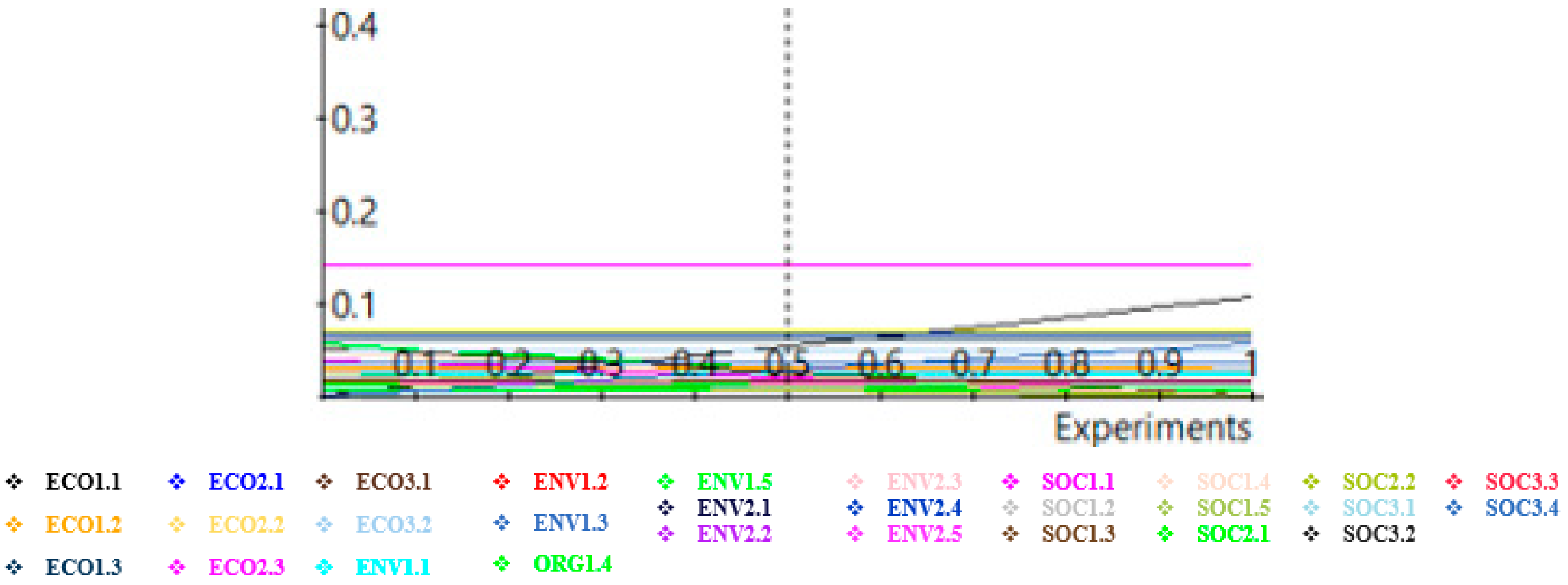
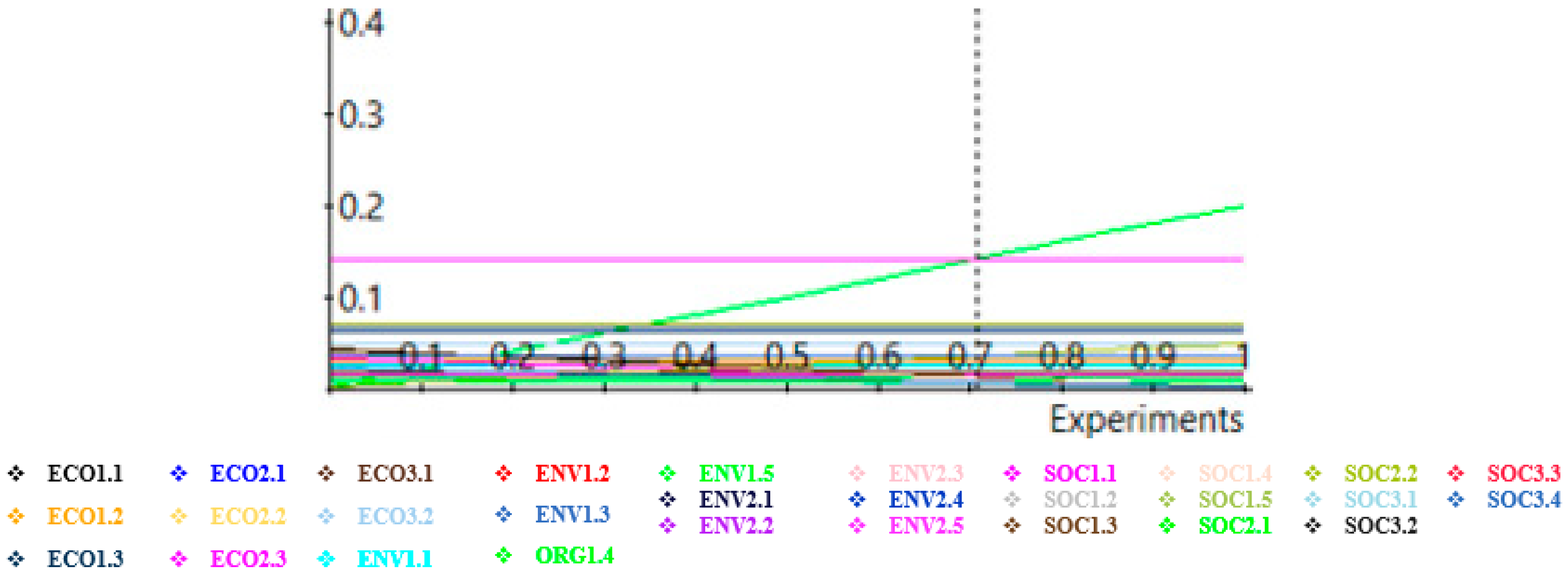

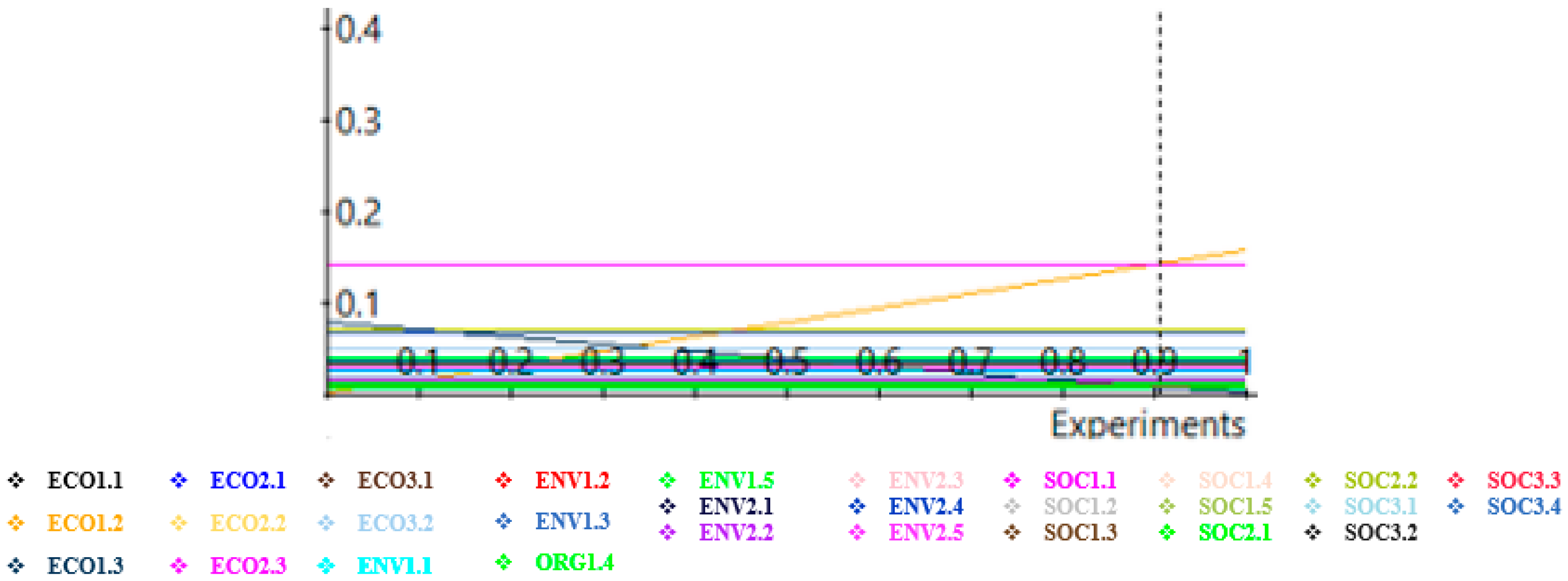
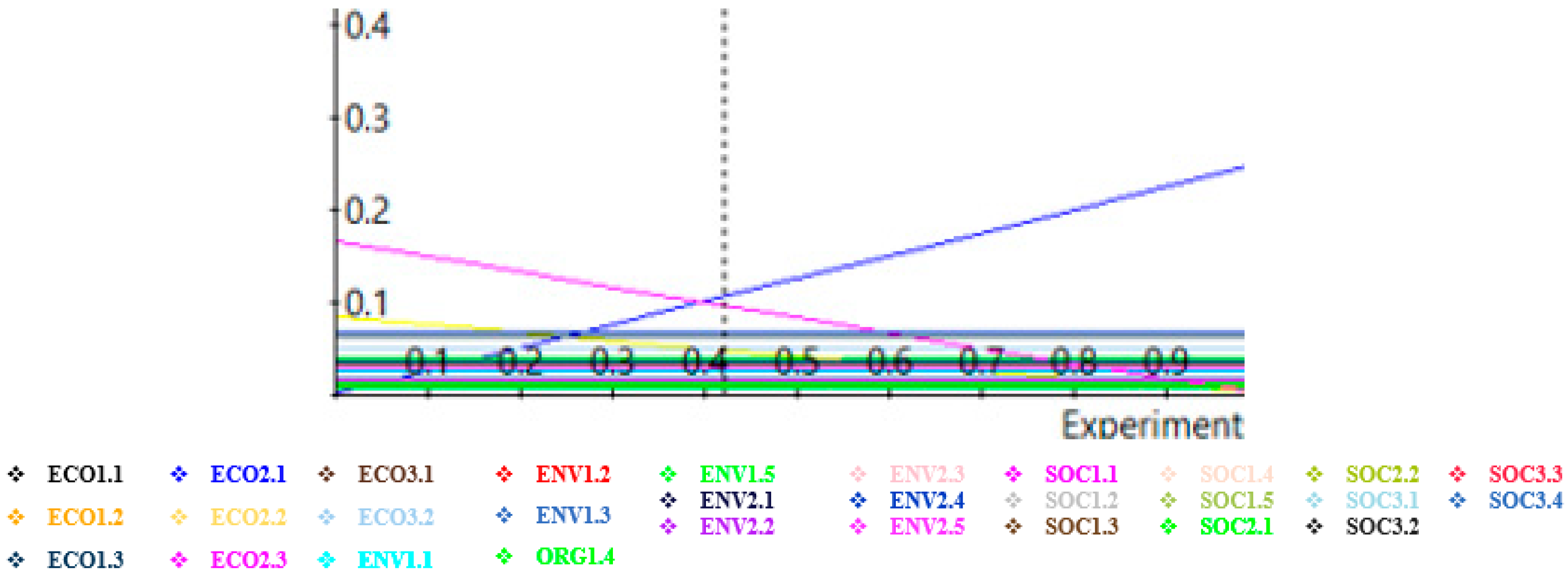

| Sustainability (SUS) | Economic sustainability (ECO) | Indicator Name | Indicator Code |
| ECO1 | ||
| ECO1.1 | ||
| ECO1.2 | ||
| ECO1.3 | ||
| ECO2 | ||
| ECO2.1 | ||
| ECO2.2 | ||
| ECO2.3 | ||
| ECO3 | ||
| ECO3.1 | ||
| ECO3.2 | ||
| Environmental sustainability (ENV) |
| ENV1 | |
| ENV1.1 | ||
| ENV1.2 | ||
| ENV1.3 | ||
| ENV1.4 | ||
| ENV1.5 | ||
| ENV2 | ||
| ENV2.1 ENV2.2 | ||
| ENV2.3 | ||
| ENV2.4 | ||
| ENV2.5 | ||
| Social sustainability (SOC) |
| SOC1 | |
| SOC1.1 | ||
| SOC1.2 | ||
| SOC1.3 | ||
| SOC1.4 | ||
| SOC1.5 | ||
| SOC2 | ||
| SOC2.1 | ||
| SOC2.2 | ||
| SOC3 | ||
| SOC3.1 | ||
| SOC3.2 | ||
| SOC3.3 | ||
| SOC3.4 | ||
| Organizational sustainability (ORG) |
| ORG1 | |
| ORG2 | ||
| ORG3 | ||
| ORG4 | ||
| ORG5 |
| Objective | Environmental | Economic | Social |
|---|---|---|---|
| Environment | 1 | 1/2 | 4 |
| Economic | 2 | 1 | 6 |
| Social | 1/4 | 1/6 | 1 |
| Expert 1 | Expert 2 | Expert 3 | Expert 4 | Expert 5 | Expert 6 | Expert 7 | Expert 8 | Expert 9 | Expert 10 | Expert 11 | Expert 12 | Expert 13 | Expert 14 | Mean | |
|---|---|---|---|---|---|---|---|---|---|---|---|---|---|---|---|
| ECO1.1 | 0.06457 | 0.01684 | 0.01437 | 0.00695 | 0.01681 | 0.0178 | 0.11085 | 0.0035 | 0.2013 | 0.12531 | 0.00129 | 0.02379 | 0.10215 | 0.016415 | 0.004223 |
| ECO1.2 | 0.02712 | 0.00735 | 0.00905 | 0.02695 | 0.01993 | 0.01121 | 0.01656 | 0.00052 | 0.2013 | 0.02737 | 0.00129 | 0.01309 | 0.10215 | 0.015346 | 0.010907 |
| ECO1.3 | 0.10249 | 0.03854 | 0.02281 | 0.00299 | 0.0709 | 0.07063 | 0.04947 | 0.00156 | 0.2013 | 0.01195 | 0.00129 | 0.04322 | 0.10215 | 0.011966 | 0.019239 |
| ECO2.1 | 0.02158 | 0.00565 | 0.00493 | 0.00887 | 0.00565 | 0.01512 | 0.16264 | 0.02135 | 0.05161 | 0.00311 | 0.01235 | 0.01965 | 0.08734 | 0.007811 | 0.012063 |
| ECO2.2 | 0.0863 | 0.0319 | 0.01128 | 0.04681 | 0.00712 | 0.06001 | 0.04415 | 0.00336 | 0.06503 | 0.01975 | 0.01235 | 0.05871 | 0.08734 | 0.015346 | 0.021815 |
| ECO2.3 | 0.0863 | 0.03002 | 0.01291 | 0.10588 | 0.02689 | 0.09525 | 0.05991 | 0.03389 | 0.04097 | 0.03135 | 0.01235 | 0.13156 | 0.08734 | 0.015076 | 0.00962 |
| ECO3.1 | 0.04854 | 0.00243 | 0.00367 | 0.04422 | 0.00365 | 0.00583 | 0.0067 | 0.00095 | 0.04628 | 0.44437 | 0.00846 | 0.00764 | 0.00448 | 0.003548 | 0.002928 |
| ECO3.2 | 0.14563 | 0.01213 | 0.00367 | 0.30954 | 0.02557 | 0.02331 | 0.02681 | 0.00758 | 0.00514 | 0.05555 | 0.00846 | 0.03821 | 0.04032 | 0.02424 | 0.00883 |
| ENV1.1 | 0.01464 | 0.01854 | 0.05262 | 0.05515 | 0.04886 | 0.16145 | 0.01438 | 0.0076 | 0.00568 | 0.00277 | 0.01251 | 0.09119 | 0.01676 | 0.004905 | 0.00883 |
| ENV1.2 | 0.03936 | 0.02433 | 0.13087 | 0.01752 | 0.04886 | 0.04519 | 0.00545 | 0.00177 | 0.00124 | 0.0007 | 0.01251 | 0.10525 | 0.01676 | 0.022318 | 0.014703 |
| ENV1.3 | 0.07742 | 0.02899 | 0.18082 | 0.0087 | 0.04886 | 0.10011 | 0.0158 | 0.02932 | 0.02506 | 0.01088 | 0.01251 | 0.11481 | 0.01676 | 0.02597 | 0.007645 |
| ENV1.4 | 0.00609 | 0.00424 | 0.10728 | 0.0044 | 0.04886 | 0.01369 | 0.00226 | 0.019 | 0.00397 | 0.00688 | 0.01251 | 0.01735 | 0.01676 | 0.001758 | 0.008155 |
| ENV1.5 | 0.01464 | 0.00766 | 0.12225 | 0.0044 | 0.04886 | 0.06625 | 0.0019 | 0.00995 | 0.00649 | 0.00432 | 0.01251 | 0.04035 | 0.01676 | 0.001758 | 0.004028 |
| ENV2.1 | 0.01316 | 0.0878 | 0.00358 | 0.0102 | 0.01764 | 0.00977 | 0.10956 | 0.0155 | 0.00989 | 0.00338 | 0.10008 | 0.02772 | 0.01676 | 0.003886 | 0.010139 |
| ENV2.2 | 0.01059 | 0.03905 | 0.0134 | 0.0038 | 0.0841 | 0.03842 | 0.03631 | 0.08703 | 0.00706 | 0.01994 | 0.10008 | 0.01158 | 0.01676 | 0.012943 | 0.003401 |
| ENV2.3 | 0.00481 | 0.0878 | 0.00888 | 0.0017 | 0.0873 | 0.02452 | 0.01971 | 0.06821 | 0.01452 | 0.01525 | 0.10008 | 0.01465 | 0.01676 | 0.006219 | 0.004658 |
| ENV2.4 | 0.02003 | 0.10249 | 0.03181 | 0.00148 | 0.03842 | 0.05178 | 0.06348 | 0.30773 | 0.00924 | 0.05469 | 0.10008 | 0.01558 | 0.01676 | 0.002467 | 0.002212 |
| ENV2.5 | 0.00212 | 0.01791 | 0.01656 | 0.00086 | 0.01683 | 0.00442 | 0.00968 | 0.13032 | 0.00174 | 0.03446 | 0.10008 | 0.00426 | 0.01676 | 0.015346 | 0.043629 |
| SOC1.1 | 0.01626 | 0.10445 | 0.0162 | 0.03508 | 0.00789 | 0.00917 | 0.02437 | 0.01089 | 0.00929 | 0.01349 | 0.0097 | 0.00708 | 0.01461 | 0.018995 | 0.019239 |
| SOC1.2 | 0.01626 | 0.09497 | 0.01829 | 0.00707 | 0.03528 | 0.02374 | 0.00729 | 0.04856 | 0.00929 | 0.00085 | 0.02511 | 0.00981 | 0.01461 | 0.001758 | 0.010913 |
| SOC1.3 | 0.03252 | 0.04028 | 0.02146 | 0.0992 | 0.03375 | 0.01568 | 0.00641 | 0.0406 | 0.00929 | 0.00295 | 0.01659 | 0.00771 | 0.01461 | 0.001758 | 0.009591 |
| SOC1.4 | 0.0172 | 0.02506 | 0.0162 | 0.05294 | 0.04763 | 0.02647 | 0.01308 | 0.02636 | 0.00929 | 0.00289 | 0.028 | 0.02398 | 0.01461 | 0.023019 | 0.01515 |
| SOC1.5 | 0.01314 | 0.02612 | 0.01073 | 0.01855 | 0.0341 | 0.05153 | 0.00396 | 0.01958 | 0.00929 | 0.00279 | 0.05451 | 0.00675 | 0.01461 | 0.000677 | 0.005435 |
| SOC2.1 | 0.00596 | 0.0606 | 0.0174 | 0.04749 | 0.00881 | 0.02961 | 0.02152 | 0.01144 | 0.02322 | 0.07714 | 0.01153 | 0.05534 | 0.06493 | 0.023019 | 0.00505 |
| SOC2.2 | 0.01788 | 0.01212 | 0.0174 | 0.04749 | 0.00881 | 0.0074 | 0.00307 | 0.00143 | 0.02322 | 0.00964 | 0.01153 | 0.05534 | 0.00812 | 0.000976 | 0.003016 |
| SOC3.1 | 0.02131 | 0.04016 | 0.01391 | 0.00698 | 0.03482 | 0.00475 | 0.02691 | 0.00698 | 0.00152 | 0.01325 | 0.02678 | 0.00339 | 0.00674 | 0.017959 | 0.02057 |
| SOC3.2 | 0.0465 | 0.01819 | 0.02826 | 0.01969 | 0.09826 | 0.01341 | 0.09358 | 0.0628 | 0.00528 | 0.00246 | 0.09293 | 0.0108 | 0.04312 | 0.017845 | 0.011315 |
| SOC3.3 | 0.0155 | 0.00582 | 0.06451 | 0.00346 | 0.01729 | 0.00236 | 0.01337 | 0.00247 | 0.00076 | 0.00072 | 0.04237 | 0.03115 | 0.01846 | 0.001758 | 0.005309 |
| SOC3.4 | 0.01208 | 0.00855 | 0.02488 | 0.00166 | 0.00826 | 0.00113 | 0.0308 | 0.01973 | 0.00174 | 0.0018 | 0.06016 | 0.01 | 0.00473 | 0.000677 | 0.005435 |
| ORG1 | 0.04565 | 0.01929 | 0.07861 | 0.30931 | 0.01857 | 0.01027 | 0.06793 | 0.00885 | 0.02698 | 0.0035 | 0.08996 | 0.06295 | 0.01012 | 0.138113 | 0.14465 |
| ORG2 | 0.00775 | 0.00405 | 0.04929 | 0.07636 | 0.01318 | 0.00639 | 0.0886 | 0.02149 | 0.02698 | 0.00445 | 0.13657 | 0.08839 | 0.00539 | 0.151281 | 0.086387 |
| ORG3 | 0.00745 | 0.01929 | 0.05947 | 0.0351 | 0.01566 | 0.03452 | 0.05486 | 0.01022 | 0.02698 | 0.00798 | 0.02075 | 0.03945 | 0.00304 | 0.026363 | 0.037927 |
| ORG4 | 0.00384 | 0.00373 | 0.02973 | 0.02084 | 0.00279 | 0.00603 | 0.0461 | 0.00527 | 0.0054 | 0.00198 | 0.00991 | 0.01953 | 0.00376 | 0.026363 | 0.077012 |
| ORG5 | 0.01884 | 0.01923 | 0.02973 | 0.14766 | 0.00791 | 0.0181 | 0.25341 | 0.00135 | 0.02698 | 0.03325 | 0.06396 | 0.03421 | 0.02299 | 0.046038 | 0.048098 |
| ECO1 | 0.17795 | 0.05861 | 0.03482 | 0.01515 | 0.10139 | 0.09214 | 0.08651 | 0.00533 | 0.53547 | 0.15621 | 0.00262 | 0.06052 | 0.29257 | 0.046038 | 0.0202 |
| ECO2 | 0.17795 | 0.06314 | 0.02193 | 0.06636 | 0.03735 | 0.15755 | 0.13044 | 0.05583 | 0.13975 | 0.05144 | 0.02515 | 0.1586 | 0.25015 | 0.046038 | 0.076352 |
| ECO3 | 0.17795 | 0.0136 | 0.00553 | 0.1453 | 0.02752 | 0.02694 | 0.01639 | 0.00813 | 0.04559 | 0.47435 | 0.01149 | 0.03464 | 0.04278 | 0.075641 | 0.057591 |
| ENV1 | 0.13943 | 0.07827 | 0.44727 | 0.03703 | 0.23009 | 0.35758 | 0.01946 | 0.06445 | 0.03763 | 0.02424 | 0.04246 | 0.27874 | 0.07999 | 0.0064 | 0.011643 |
| ENV2 | 0.04648 | 0.31307 | 0.05591 | 0.00741 | 0.23009 | 0.11919 | 0.11677 | 0.58006 | 0.03763 | 0.12118 | 0.33971 | 0.05575 | 0.07999 | 0.0019 | 0.002462 |
| SOC1 | 0.08742 | 0.2718 | 0.06242 | 0.08741 | 0.14943 | 0.11705 | 0.02696 | 0.13911 | 0.04118 | 0.02179 | 0.0909 | 0.04181 | 0.06974 | 0.075641 | 0.028796 |
| SOC2 | 0.02186 | 0.06795 | 0.02622 | 0.03901 | 0.0166 | 0.03422 | 0.01203 | 0.01227 | 0.04118 | 0.08235 | 0.01565 | 0.08362 | 0.06974 | 0.006021 | 0.007315 |
| SOC3 | 0.08742 | 0.06795 | 0.09908 | 0.01306 | 0.14943 | 0.02002 | 0.08054 | 0.08764 | 0.00824 | 0.01729 | 0.15086 | 0.04181 | 0.06974 | 0.008788 | 0.015079 |
| ECO | 0.53386 | 0.13536 | 0.06228 | 0.22681 | 0.16626 | 0.27662 | 0.23334 | 0.06929 | 0.72081 | 0.682 | 0.03926 | 0.25375 | 0.5855 | 0.008788 | 0.023936 |
| ENV | 0.1859 | 0.39134 | 0.50317 | 0.04444 | 0.46018 | 0.47678 | 0.13623 | 0.64452 | 0.07527 | 0.14542 | 0.38217 | 0.33449 | 0.15998 | 0.006021 | 0.006308 |
| SOC | 0.19669 | 0.40771 | 0.18772 | 0.13948 | 0.31546 | 0.17129 | 0.11953 | 0.23902 | 0.09059 | 0.12142 | 0.25742 | 0.16724 | 0.20923 | 0.006021 | 0.010198 |
| ORG | 0.08354 | 0.06559 | 0.24683 | 0.58927 | 0.0581 | 0.07531 | 0.5109 | 0.04718 | 0.11333 | 0.05116 | 0.32115 | 0.24452 | 0.04529 | 0.008788 | 0.037997 |
| SUS | 1.0000 | 1.0000 | 1.0000 | 1.0000 | 1.0000 | 1.0000 | 1.0000 | 1.0000 | 1.0000 | 1.0000 | 1.0000 | 1.0000 | 1.0000 | 0 | 0.999999 |
| Criteria Level | Sustainability Indicators | Normalized Weights | Ranking of Level 1 | Ranking of Level 2 | Ranking of Level 3 |
|---|---|---|---|---|---|
| Level 1 | ECO | 0.41809 | 1 | ||
| ENV | 0.24969 | 2 | |||
| SOC | 0.22259 | 3 | |||
| ORG | 0.10962 | 4 | |||
| Level 2 | ECO1 | 0.13902 | 3 | ||
| ECO2 | 0.22069 | 1 | |||
| ECO3 | 0.05839 | 7 | |||
| ENV1 | 0.08323 | 5 | |||
| ENV2 | 0.16646 | 2 | |||
| SOC1 | 0.10983 | 4 | |||
| SOC2 | 0.04358 | 8 | |||
| SOC3 | 0.06918 | 6 | |||
| ORG1 | 0.02948 | 10 | |||
| ORG2 | 0.01823 | 12 | |||
| ORG3 | 0.02114 | 11 | |||
| ORG4 | 0.00712 | 13 | |||
| ORG5 | 0.03365 | 9 | |||
| Level 3 | ECO1.1 | 0.06245 | 4 | ||
| ECO1.2 | 0.03123 | 12 | |||
| ECO1.3 | 0.06245 | 4 | |||
| ECO2.1 | 0.03541 | 10 | |||
| ECO2.2 | 0.07082 | 2 | |||
| ECO2.3 | 0.14163 | 1 | |||
| ECO3.1 | 0.01639 | 19 | |||
| ECO3.2 | 0.04918 | 5 | |||
| ENV1.1 | 0.02482 | 16 | |||
| ENV1.2 | 0.01371 | 21 | |||
| ENV1.3 | 0.03673 | 8 | |||
| ENV1.4 | 0.00718 | 26 | |||
| ENV1.5 | 0.01104 | 23 | |||
| ENV2.1 | 0.02866 | 14 | |||
| ENV2.2 | 0.04773 | 6 | |||
| ENV2.3 | 0.02866 | 14 | |||
| ENV2.4 | 0.06678 | 3 | |||
| ENV2.5 | 0.01512 | 20 | |||
| SOC1.1 | 0.02647 | 15 | |||
| SOC1.2 | 0.01308 | 22 | |||
| SOC1.3 | 0.03543 | 9 | |||
| SOC1.4 | 0.03113 | 13 | |||
| SOC1.5 | 0.01723 | 18 | |||
| SOC2.1 | 0.03916 | 7 | |||
| SOC2.2 | 0.00979 | 24 | |||
| SOC3.1 | 0.00951 | 25 | |||
| SOC3.2 | 0.03291 | 11 | |||
| SOC3.3 | 0.01764 | 17 | |||
| SOC3.4 | 0.01764 | 17 |
| Criteria Level | Sustainability Indicators | Normalized Weights | Ranking of Level 1 | Ranking ofLevel 2 | Ranking of Level 3 | |
|---|---|---|---|---|---|---|
| Level 1 | Economic pillar | ECO | 0.41809 | 1 | ||
| Environmental pillar | ENV | 0.24969 | 2 | |||
| Social pillar | SOC | 0.22259 | 3 | |||
| Organizational pillar | ORG | 0.10962 | 4 | |||
| Level 2 | Economic performance | ECO2 | 0.22069 | 1 | ||
| Encouraging green responses | ENV2 | 0.16646 | 2 | |||
| Economic contribution | ECO1 | 0.13902 | 3 | |||
| Work conditions | SOC1 | 0.10983 | 4 | |||
| Reducing pollution pressures | ENV1 | 0.08323 | 5 | |||
| Social responsibility | SOC3 | 0.06918 | 6 | |||
| Economic incentives | ECO3 | 0.05839 | 7 | |||
| Skills enhancement | SOC2 | 0.04358 | 8 | |||
| Innovation | ORG5 | 0.03365 | 9 | |||
| Strategy | ORG1 | 0.02948 | 10 | |||
| Risk management | ORG3 | 0.02114 | 11 | |||
| Policy | ORG2 | 0.01823 | 12 | |||
| Public relations | ORG4 | 0.00712 | 13 | |||
| Level 3 | Quality | ECO2.3 | 0.14163 | 1 | ||
| Efficiency | ECO2.2 | 0.07082 | 2 | |||
| Waste management | ENV2.4 | 0.06678 | 3 | |||
| Capital investment | ECO1.1 | 0.06245 | 4 | |||
| Revenues increase | ECO1.3 | 0.06245 | 4 | |||
| Supportive infrastructure | ECO3.2 | 0.04918 | 5 | |||
| Treated water | ENV2.2 | 0.04773 | 6 | |||
| Education | SOC2.1 | 0.03916 | 7 | |||
| Water pollution | ENV1.3 | 0.03673 | 8 | |||
| Safety | SOC1.3 | 0.03543 | 9 | |||
| Capacity | ECO2.1 | 0.03541 | 10 | |||
| Job provision | SOC3.2 | 0.03291 | 11 | |||
| Foreign direct investment | ECO1.2 | 0.03123 | 12 | |||
| Security | SOC1.4 | 0.03113 | 13 | |||
| Green energy | ENV2.1 | 0.02866 | 14 | |||
| Green materials | ENV2.3 | 0.02866 | 14 | |||
| Healthcare | SOC1.1 | 0.02647 | 15 | |||
| Greenhouse gas emissions | ENV1.1 | 0.02482 | 16 | |||
| Surrounding society development | SOC3.3 | 0.01764 | 17 | |||
| Work hour standardization | SOC3.4 | 0.01764 | 17 | |||
| Welfare | SOC1.5 | 0.01723 | 18 | |||
| Tax incentives | ECO3.1 | 0.01639 | 19 | |||
| Landscape | ENV2.5 | 0.01512 | 20 | |||
| Air pollution—other pollutants | ENV1.2 | 0.01371 | 21 | |||
| Housing | SOC1.2 | 0.01308 | 22 | |||
| Land pollution | ENV1.5 | 0.01104 | 23 | |||
| Training | SOC2.2 | 0.00979 | 24 | |||
| Gender equality | SOC3.1 | 0.00951 | 25 | |||
| Noise pollution | ENV1.4 | 0.00718 | 26 |
Disclaimer/Publisher’s Note: The statements, opinions and data contained in all publications are solely those of the individual author(s) and contributor(s) and not of MDPI and/or the editor(s). MDPI and/or the editor(s) disclaim responsibility for any injury to people or property resulting from any ideas, methods, instructions or products referred to in the content. |
© 2023 by the authors. Licensee MDPI, Basel, Switzerland. This article is an open access article distributed under the terms and conditions of the Creative Commons Attribution (CC BY) license (https://creativecommons.org/licenses/by/4.0/).
Share and Cite
Alansary, O.S.-a.; Al-Ansari, T. Developing a Strategic Sustainability Assessment Methodology for Free Zones Using the Analytical Hierarchy Process Approach. Sustainability 2023, 15, 9921. https://doi.org/10.3390/su15139921
Alansary OS-a, Al-Ansari T. Developing a Strategic Sustainability Assessment Methodology for Free Zones Using the Analytical Hierarchy Process Approach. Sustainability. 2023; 15(13):9921. https://doi.org/10.3390/su15139921
Chicago/Turabian StyleAlansary, Omar Sharaf-addeen, and Tareq Al-Ansari. 2023. "Developing a Strategic Sustainability Assessment Methodology for Free Zones Using the Analytical Hierarchy Process Approach" Sustainability 15, no. 13: 9921. https://doi.org/10.3390/su15139921
APA StyleAlansary, O. S.-a., & Al-Ansari, T. (2023). Developing a Strategic Sustainability Assessment Methodology for Free Zones Using the Analytical Hierarchy Process Approach. Sustainability, 15(13), 9921. https://doi.org/10.3390/su15139921






